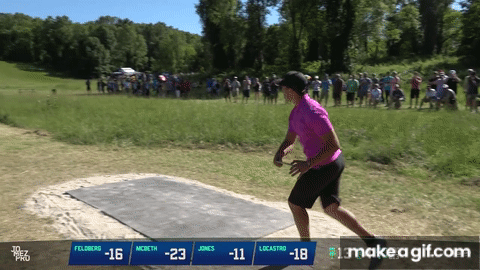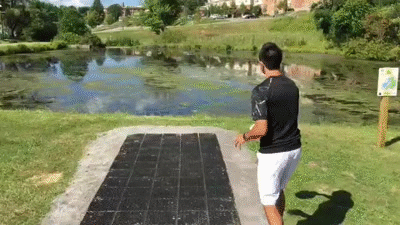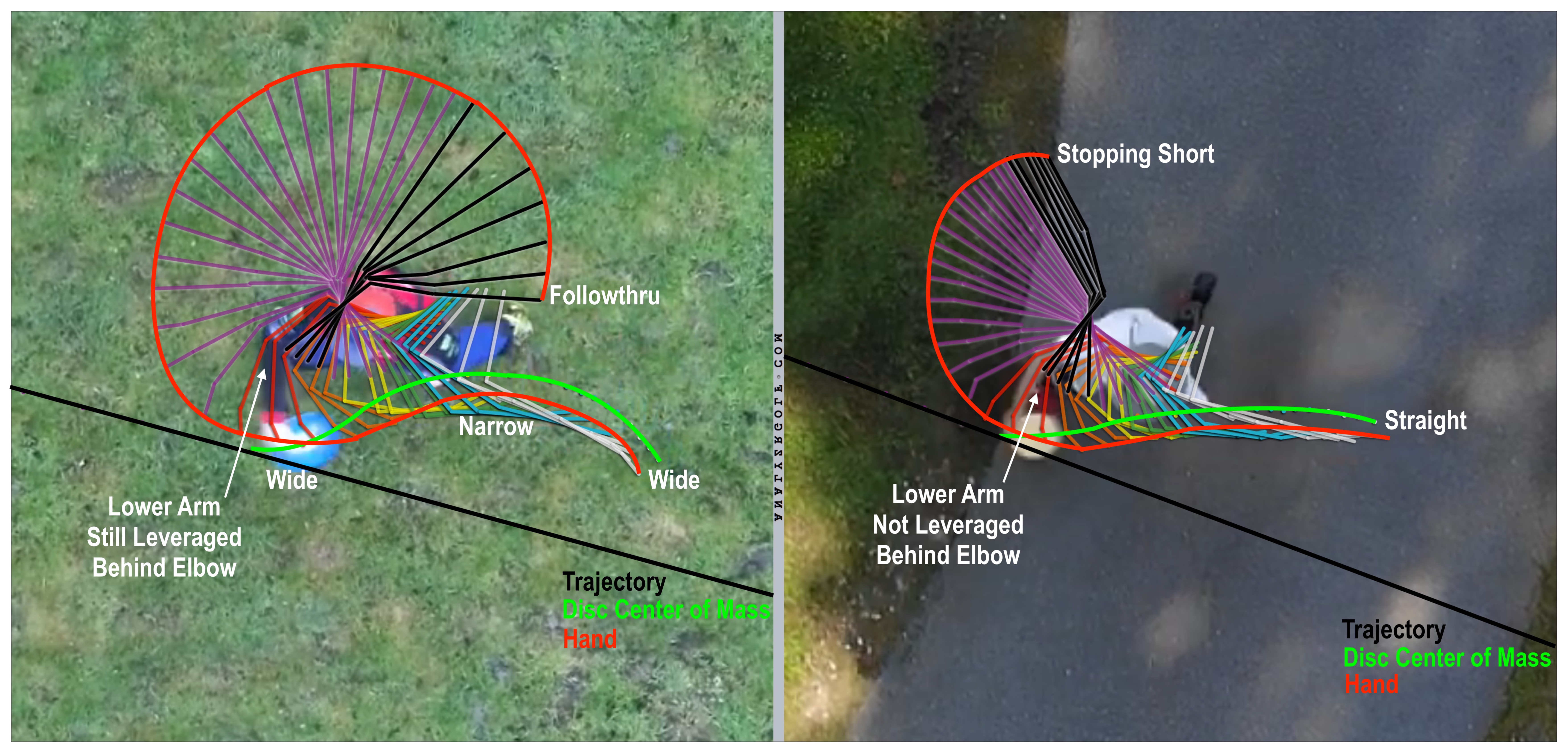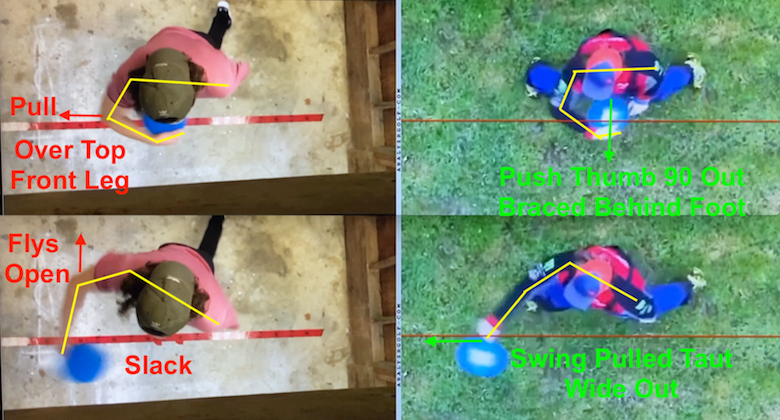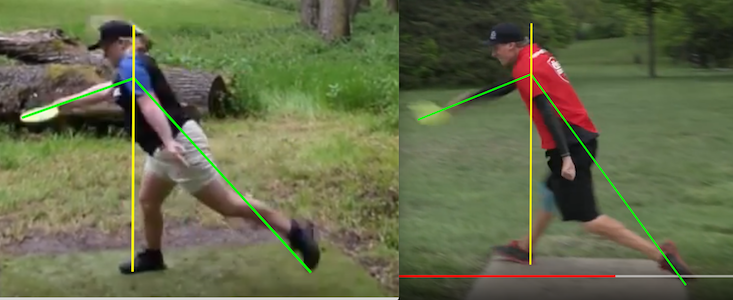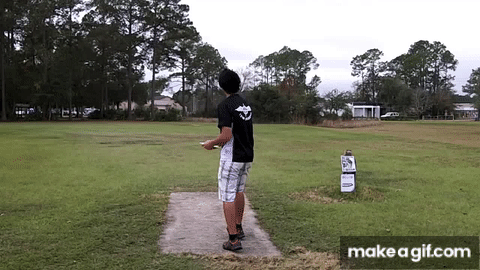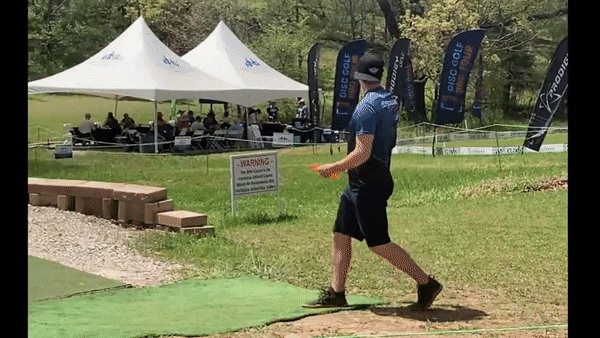YW. Right, the "deep concept" is commiting the primary force of the move
at the release point "sideways" (and perpendicular to the plant foot angle, for the most part). Yes, there is variation around that theme, and bodies vary, but IMHO this is a very powerful simplifying concept. Any time I've gone astray it pulls me back. When I 'Look to the moon' it's the apex of the shot. Let the disc take over from there. So more or less when you tee off, you're trying to figure out where you land in the plant relative to the shot apex. That's part of the idea behind
Finish & address which you'll see a lot of pros use.
Good Q.
Short answer: It's about how the action of the arm/shoulders/core relate to the lower body as you shift your weight into the plant.
That's part of why I think SW wanted you to try the "straight back from trajectory" reachback- based on how your body naturally wants to shift its weight down the tee, he was trying to get the disc "directly away" from the trajectory because he predicted that your body would naturally (potentially) go wide-narrow-wide like the pro pick on its own. Basically a lot of his coaching points are trying to nudge peoples' bodies into that pattern based on where they currently are without micromanaging it. So I wasn't trying to be dismissive about your questions, but that's why I've learned just to do my best to implement literally what he says. If it doesn't work after a bit maybe there's another problem and it's time to try something else.
Yes, I see you doing this and it's part of why I gave you the advice to settle in and grind a single thing once your coach points it out. Psychologists call this "exploring vs. exploiting" in learning and decision making. It all depends on what you're trying to maximize. If it's long term rewards (here, those would be good form & consistency/power), it's
good to explore. However, when you find something that's working
you should exploit it.
I'm not as developed an athlete as you, but usually -if the coach is good- exploring what they said for a bit is good with significantly less exploring on your own. Imagine wandering out into a forest without a map and compass. Sure, you might make it to the food and water. Or you might die in the wilderness. Depends on you and the woods. I've found that my own progress improved when I tried to dutifully do exactly what SW said. Many times I have had trouble doing it. But I usually stick with it 2-3 weeks until it "sticks" or completely fails, then the cycle repeats.
Interestingly, exploring has its benefits. For example, since I've "explored" almost all of SW's drill set, I think he can get through to me
much faster for any given change conceptually and I can usually try it out right away rather than fumbling around for hours or days. That also means I 'bounce back' to old things that work better now that other things are more developed. I also am getting much faster at predicting what he's going to tell me to do, but I've learned to say less about it until he says it. The rest is just noise. And sometimes I'm still wrong and that's when the learning is about to accelerate again. But interestingly, no matter what he teaches me, it takes between 2-3 weeks before the learning stabilizes, just like every other motor skill I've ever tried to learn. And everyone has an Achilles' heel, I believe - mine is probably that my body/brain just
do not want to commit my full mAss into the move sideways, so I am always battling with that and it helps explain patterns in where my form regresses fastest. With my first tournament coming up in two weeks I plan to stick with the recent & last change he just gave me and get as good as I can at those to my body's capacity, then see where I'm at. All of these insights and decisions result from learning from a
lot of mistakes while becoming a smarter student.
Your own learning trajectory will differ from mine and I suspect you're going to learn a few things
much faster, but I'd just caution your "explore" space if you're also getting coaching input. There's science to back that up.
Yes, a flinging open dingle arm attached at the shoulder, which is guided by your whole posture and move down the tee might be what I'd tell you in particular. Mine started to work better after using a lot of club drills like WeckMethod.
Your ourward/sideways Q is good. I would say (1) yes, the
overall move commits the force sideways. You always need to filter the move from that main concept. You can think of the move into the release to function more like a basketball push pass where the thumb is thrown/leveraged toward the target. Other people use more of a windmill forward so the back of their hand is moving a little more directly toward the target. I work the most on using the first one because it works better in the context of the rest of my form, and adds additional leverage and late acceleration. Sidewinder pointed it out to me a long time ago, and I still work on it. Yours might end up a little different based on your overall move and how your arm works in general. But remember- commit the force of the
overall move sideways.
Playing with "pull" concepts (broadly speaking) did help me figure out how to reconcile "dingle arm" with "pull," and gradually made it easier for me to find the "deep pocket." Then I went back to working on the arm leverage as mentioned above. But for you, I'm trying to gently nudge you to realize that (1) playing with the "straight back" relative to trajectory and (2) let your shift/posture help create the curvilinear path and "deep pocket" is going to be on the agenda either way.
Driving in a straight line or "pulling" the way most people mean usually doesn't go very well unless the rest of their posture control is already good, which is why I wrote what I wrote in that lengthy piece before.
Wrist curl can be ok as long as you get leverage at the end of the move. I used to have what I call "floppy wrist syndrome" so it's possible to muck it up (again, clubs, hammers, etc. were the way to go there). Maybe look at Kyle Klein for a more straight-wristed example - his tends to remain laser straight.
